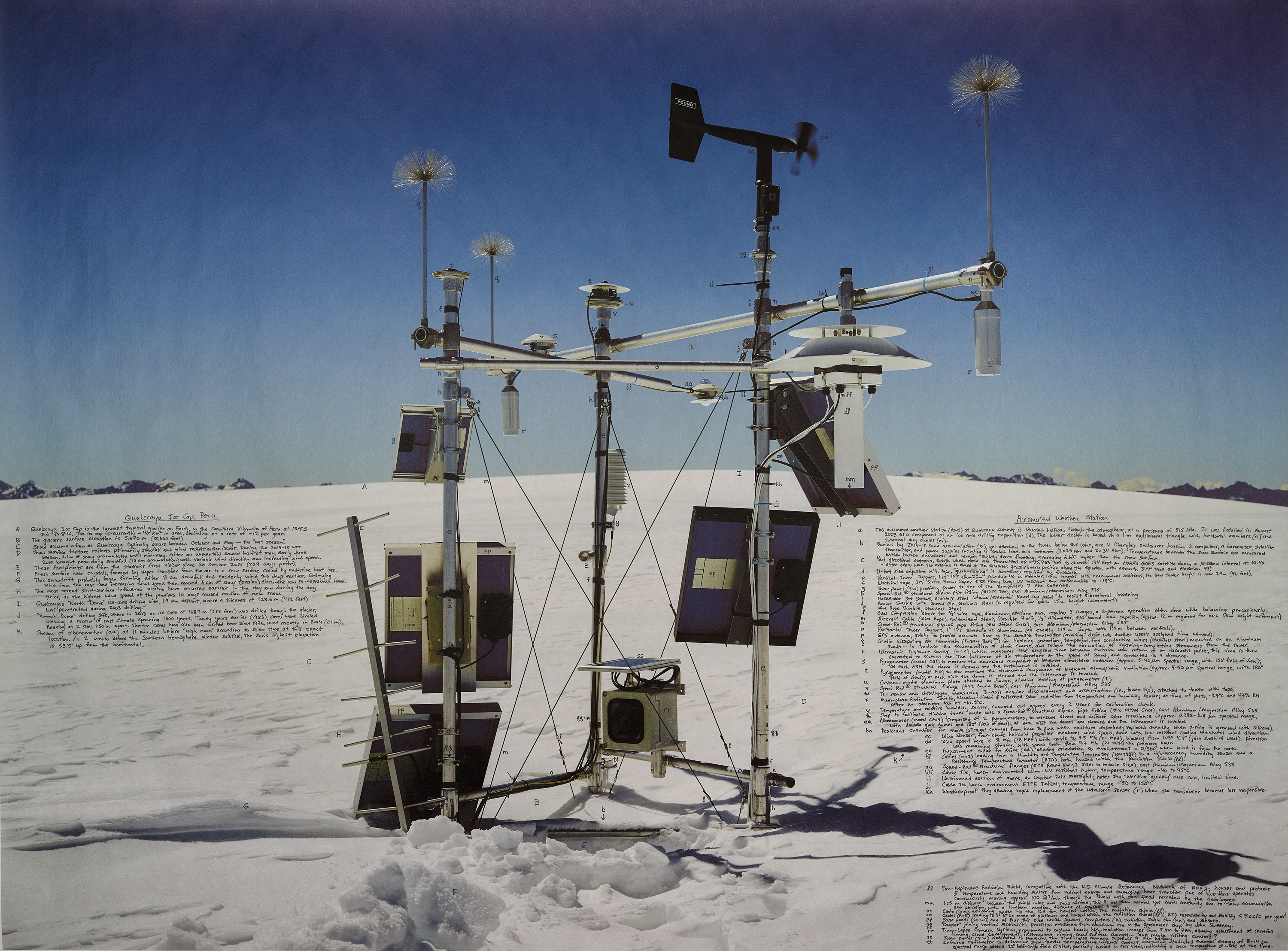Earth Week: Ian van Coller: Naturalists of the Long Now

© Ian van Coller, Quelccaya Automated Weather Station, Quelccaya Glacier, Peru, 2015. Annotations by Douglas Hardy PhD. Unique Pigment Print on Washi, 30”x40”
These bodies of work are linked by this thematic lens: making the often-invisible nature of the global climate and the ecological crisis more visible using conceptual, lens-based art techniques. Each body of work speaks to a different aspect of the climate and ecological crisis: sea level rise; coral bleaching; habitat loss and environmental destruction; deforestation; melting glaciers; plastic pollution. – Micahel O. Snyder

© Ian van Coller, Bighorn Sheep Kill Site, Beartooth Mountains, Montana, 2017. Annotations by Craig Lee PhD, Unique Pigment Print on Washi, 31”x38”
Ian van Coller was born and raised in South Africa. He moved to the United States in 1992 where he received a BFA from Arizona State University and MFA from the University of New Mexico. Van Coller has been a Professor of Photography at Montana State University in Bozeman since 2006 where he lives with his wife, and dogs Sophie and Biko. His work has been widely exhibited in the United States and internationally, and is included in over fifty public collections, including The Metropolitan Museum of Art, The Philadelphia Museum of Art, and The Getty Research Institute. Van Coller is a 2018 John Simon Guggenheim fellow as well as a fellow of The Explorers Club.
Follow Ian van Coller on Instagram: @ianvancoller

© Ian van Coller, Bison Jump Site, Montana, 2022. Annotations by Nancy M. Mahoney, Unique Pigment Print on Rag Paper, 42”x38”
Naturalists of the Long Now
Climate change has compressed and conflated human and geologic time scales, making it essential to find ways to conceptualize “deep time.” My project, Naturalists of the Long Now, seeks to make notions of deep time comprehensible through visual exploration of glacier ice, as well as other earthly archives. Initially inspired by the 10,000 Year Clock Project of the Long Now Foundation, I have been collaborating with paleoclimatologists to make art that challenges viewers to think about the vast scales of geologic time—both past and future—that are recorded in the earth’s ice bodies, trees, sediments, and fossils.
In 2015, I was able to accompany a team of geoscientists who specialize in climate science related to Quelccaya Glacier in Peru. I was astonished at the endurance of these men and women. Every day they would climb to the summit of the glacier at 18,600ft, and then work over 10 hours straight, drilling ice cores, digging snow pits, and collecting data. It would be exhausting work at sea level, let alone at altitude. I realized I really had a lack of understanding of what the scientists were trying to do. Where the symbolic conversations in my ice portraits ended, the deep knowledge of ice possessed by the scientists would sustain and expand it.
When I was a young person, I was fascinated by the annotated drawings and paintings of Victorian era naturalists, botanists, and ornithologists. These brought together the two things I loved most in the world—art and nature. Since that expedition to Peru, I have been making intimate collaborations with scientists by having them annotate directly onto my photographic prints—a contemporary taxonomy of ice and climate—thus re-inventing a genre of naturalist imagery.
Naturalists of the Long Now breaks down barriers between art and science, and creates a dialogue between text and image, landscape and viewer, expert, and novice, past, present, and future. My intention is that Naturalists of the Long Now is to encourage people to think in terms of longer spans of time and consider what humanity and nature will look like in 100 or even 10,000 years—instead of just considering our personal and immediate desires. – Ian van Coller

© Ian van Coller, Bristlecone Pine, Great Basin National Park, Nevada, 2022. Annotations by Brian Smithers PhD. Unique Pigment Print on Washi, 43”x55”

© Ian van Coller, Dinwoody Glacier, Wind River Wilderness, Wyoming, 2024. Annotations by Carsten Braun PhD. Unique Pigment Print on Rag paper, 23”x32”

© Ian van Coller, Fairy Lake Mud-Core, Montana, 2016. Annotations by James Benes. Unique Pigment Print on Washi, 40”x30”

© Ian van Coller, Gallatin River Caddisflies, Montana, 2017. Annotations by Jenny McCarty. Unique Pigment Print on Washi, 32”x40”

© Ian van Coller, Dr. Avila Holding Cut Antarctic Ice-Core, Montana State University, 2017. Annotations by Pamela Santibanez Avila PhD, Unique Pigment Print on Washi, 35”x46”

© Ian van Coller, Sastrugi, Antarctica, 2021, Annotations by Ian van Coller. Unique Pigment Print on Rag paper

© Ian van Coller, Stanley Glacier, Mount Stanley, Rwenzori Mountains, Uganda, 2020. Annotations by Carsten Braun PhD, Unique Pigment Print on Rag paper, 27”x36”
Posts on Lenscratch may not be reproduced without the permission of the Lenscratch staff and the photographer.
Recommended
-
Hillerbrand+Magsamen: nothing is precious, everything is gameOctober 12th, 2025
-
BEYOND THE PHOTOGRAPH: Q&A WITH PHOTO EDITOR JESSIE WENDER, THE NEW YORK TIMESAugust 22nd, 2025
-
Christa Blackwood: My History of MenJuly 6th, 2025
-
BEYOND THE PHOTOGRAPH: Researching Long-Term Projects with Sandy Sugawara and Catiana García-KilroyMarch 27th, 2025
-
Dodeca Meters: Arielle Rebek, Kareem Michael Worrell, and Lindsay BuchmanFebruary 7th, 2025


























































